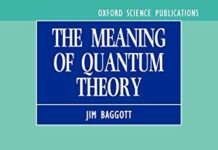
Ebook Info
- Published: 2017
- Number of pages: 320 pages
- Format: PDF
- File Size: 2.66 MB
- Authors: Jim Baggott
Description
Everything around us is made of ‘stuff’, from planets, to books, to our own bodies. Whatever it is, we call it matter or material substance. It is solid; it has mass. But what is matter, exactly? We are taught in school that matter is not continuous, but discrete. As a few of the philosophers of ancient Greece once speculated, nearly two and a half thousand years ago, matter comes in ‘lumps’, and science has relentlessly peeled away successive layers of matter to reveal its ultimate constituents.Surely, we can’t keep doing this indefinitely. We imagine that we should eventually run up against some kind of ultimately fundamental, indivisible type of stuff, the building blocks from which everything in the Universe is made. The English physicist Paul Dirac called this ‘the dream of philosophers’. But science has discovered that the foundations of our Universe are not as solid or as certain and dependable as we might have once imagined. They are instead built from ghosts and phantoms, of a peculiar quantum kind. And, at some point on this exciting journey of scientific discovery, we lost our grip on the reassuringly familiar concept of mass.How did this happen? How did the answers to our questions become so complicated and so difficult to comprehend? In Mass Jim Baggott explains how we come to find ourselves here, confronted by a very different understanding of the nature of matter, the origin of mass, and its implications for our understanding of the material world. Ranging from the Greek philosophers Leucippus and Democritus, and their theories of atoms and void, to the development of quantum field theory and the discovery of a Higgs boson-like particle, he explores our changing understanding of the nature of matter, and the fundamental related concept of mass.
User’s Reviews
Editorial Reviews: Review “The book is very clearly structured and has a glossary, so ‘dipping’ is facilitated. The author condenses and combines sources as listed in his bibliography.” — Michael Jewess, Royal Society of Chemistry Historical Group newsletter”Jim Baggott is one of the UK’s best popular science writers and never disappoints. . . . [Mass] encourages the reader to really think about the nature of matter and how something as apparently straightforward as mass is not what it seems. That delight in revealing the unexpected typifies, for me, the joy of physics.” –Popular Science Book Reviews”How did our understanding of mass evolve from the geometric atoms of ancient Greece to the quantum ghostliness of today? Jim Baggott ingeniously contextualizes that eventful science history.” –Barbara Kiser, Nature “Encourages the reader to really think about the nature of matter and how something as apparently straightforward as mass is not what it seems. That delight in revealing the unexpected typifies, for me, the joy of physics.” –Brian Clegg, Popular Science “Baggott smartly renders particle physics, typically a dense and opaque topic for the non-expert, clear and captivating. Not only will readers grasp the building blocks of the standard model, they will forever look at mass differently.” –Publishers Weekly “An imaginative book that seeks the answer to the question, what is matter? … Baggott provides a wild but expert and comprehensive ride.” –Kirkus Review About the Author Jim Baggott, Freelance science writerJim Baggott is a freelance science writer. He was a lecturer in chemistry at the University of Reading but left to work with Shell International Petroleum Company and then as an independent business consultant and trainer. His many books include Origins: The Scientific Story of Creation (OUP, 2015), Higgs: The Invention and Discovery of the ‘God Particle’ (OUP, 2012), A Quantum Story: A History in 40 Moments (OUP, 2011) and A Beginner’s Guide to Reality (Penguin, 2005), Quantum Reality: The Quest for the Real Meaning of Quantum Mechanics ― A Game of Theories (OUP, 2020), and The Quantum Cookbook: Mathematical Recipes for the Foundations of Quantum Mechanics (OUP, 2020).
Reviews from Amazon users which were colected at the time this book was published on the website:
⭐I’d already become a Jim Baggott fan after reading “Quantum Space”.I just finished “Mass” today, and felt appreciation for the time & effortJim put into the book, so wanted to review it while the afterglow lasted.”Mass” began a bit slow as he built the historical foundation in 4 Chapterscomprising Part I. I wasn’t that interested at first, and almost laid it aside, but gladI pressed on. In fact, I glossed over those chapters, wanting to get to the “meat”.Part II still went over historical experiments, but was helpful in setting the stagefor the most important information for me…..wave function, particles, types of force.Jim takes care to explain without long convoluted sentences. He includes humorand humility, assumes the reader does not have an advanced degree in math or physics,but doesn’t dumb it down. I imagine even those who are physicists will appreciate histeaching, as he brings it all together.He includes an extensive glossary, which is very helpful by itself. Going through it todayI realized I should have used the glossary as I was reading through the book.The previous 5 Star reviews are right on.I’ve ordered a copy of his book, “Higgs: The Invention and Discovery of the ‘God Particle’ “,but will go back and re-read “Mass” making use of the glossary.It may be even better 2nd time around.Like a good loaf of fresh sourdough bread….I’m still chewing & savoring it.BTW, also recommend his lectures on YouTube. 😉
⭐, I am a brazilian retired electrical engineer, living in Rio de Janeiro, and I have just finished reading your book MASS.I think your book explain in a easily understood way all the universe.What we call particles are nothing than interferences (peaks ans toughs) of all quantuum fields that permeate the universe and this solve o problem that is how a particle, something with zero size, could have mass and electrical charge. And mass is nothhing than the energy (m=E/c2) that mantain the quarks together forming the nucleus of theprotons and neutrons. Simple. Mass is not anymore the unexplained “substance” of things. And more:what we call particles (now quantuum fields) move in the quantuum Higgs fied that permeate all universe and doing this make ripples in the Higgs field as a body moving in mollasses. These ripples, ondulations, are very strong (relatively) inside the galaxies and the net effect is as there is more mass than the sum of the intrinsec masses (energy) of the stars of the galaxy. This is the unexplained (up to now) dark matter Among the galaxies these ripples are much more smooth but enough to push the galaxies far from each other. This is the expansion of the universe and the unexplained (up to now again) dark energy.The ripples of the fields specially Higgs causes the curvature of space time in other words, causes gravitation. Gravity in no more a force caused by masses or a curvature of space also caused by masses as thought Newton and Einstein but a curvature of space time caused by ripples of the fields that are the only reality!Great Book! Explain Mass, Gravity, Dark Matter, Dark Energy, Universe Expansion and more You deserve a Noble Prize! Congratulation Paulo (Fernando Veiga do) Amaral
⭐From Richard Feynman’s Lectures on Physics:”If, in some cataclysm, all of scientific knowledge were to be destroyed, and only one sentence passed on to the next generation of creatures, what statement would contain the most information in the fewest words? I believe it is the atomic hypothesis that all things are made of atoms — little particles that move around in perpetual motion, attracting each other when they are a little distance apart, but repelling upon being squeezed into one another. In that one sentence, you will see, there is an enormous amount of information about the world, if just a little imagination and thinking are applied.”This book turned out being an important piece in my personal attempt to piece a puzzle of modern physics and our world – applied to biology (quantum biology). We live in exciting times, this is one keyhole you should peer through to get a glimpse of where we’re going next in our understanding. And.. it’s all about information processing, that’s the very foundation of life.
⭐I graduated high school intending to be a physicist, but quickly found that my small, rural high school had not prepared me. I had never heard the term “calculus” until my freshmen physics glass in college. (This was the mid- 1960s, so there was no Google, in fact, there was no internet). I switched to engineering and had a successful and satisfying career in the petroleum industry after graduation from college, but have always remained interested in physics. I am the only person I personally know who was exited to hear that the Higgs boson had apparently been discovered. This book is not for everyone, but it is well written, informative, and full of ideas to contemplate for those interested.
⭐This was an excellently well written treatise covering the history and current status of quantum mechanics. The math scattered throughout the chapters was very easy going for anyone at a high school level. The author’s style and organization of the material made for an enjoyable ride from Democritus to Higgs. I highly recommend this for the quantum minded!
⭐Mass without mass. As strange as the universe of general relativity appears, that strangeness pales in comparison to the strangeness of quantum chromodynamics and Higgs bosons. Baggott does as great a job as I have ever encountered of making this strange new understanding of reality accessible. If you are comfortable with the concept that atoms are made from protons, neutrons, and electrons, then you owe it to yourself to read Mass. You’ll gain an understanding of the weird world of quarks, gluons, and colour forces, and how these strange constituents of the subatomic world lie at the foundation of reality, joining together to make protons and neutrons, and holding them together to make an atom. Great stuff and great fun!
⭐Non è un’opera accademica, ma è davvero eccellente come libro divulgativo su un tema complesso e profondo.
⭐
⭐È una straordinaria cavalcata alla scoperta della più intima natura della realtà materiale che ci circonda e di cui noi stessi siamo fattie che, in ultima analisi, accompagna anche un lettore “non addetto ai lavori” verso una più profonda comprensione del significato reale dell’ equazione di Einstein m = E/c2
⭐
⭐This book treats a very difficult subject with impressive clarity. Highly recommended.
⭐I’ve puzzeled over what mass actually is and this book goes a long way to explaining the latest ideas on the subject. Even if you don’t understand everything the book is well worth reading for the historical context on the concept of mass.
⭐Arrived on time. Excellent treatment of the subject. I enjoyed the read.
Keywords
Free Download Mass: The quest to understand matter from Greek atoms to quantum fields in PDF format
Mass: The quest to understand matter from Greek atoms to quantum fields PDF Free Download
Download Mass: The quest to understand matter from Greek atoms to quantum fields 2017 PDF Free
Mass: The quest to understand matter from Greek atoms to quantum fields 2017 PDF Free Download
Download Mass: The quest to understand matter from Greek atoms to quantum fields PDF
Free Download Ebook Mass: The quest to understand matter from Greek atoms to quantum fields



